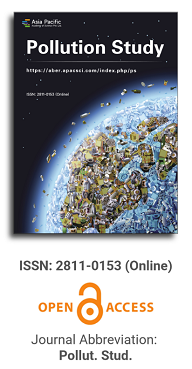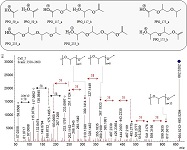
Asia Pacific Academy of Science Pte. Ltd. (APACSCI) specializes in international journal publishing. APACSCI adopts the open access publishing model and provides an important communication bridge for academic groups whose interest fields include engineering, technology, medicine, computer, mathematics, agriculture and forestry, and environment.

The (partial) replacement of synthetic polymers with bioplastics is due to increased production of conventional packaging plastics causing for severe environmental pollution with plastics waste. The bioplastics, however, represent complex mixtures of known and unknown (bio)polymers, fillers, plasticizers, stabilizers, flame retardant, pigments, antioxidants, hydrophobic polymers such as poly(lactic acid), polyethylene, polyesters, glycol, or poly(butylene succinate), and little is known of their chemical safety for both the environment and the human health. Polymerization reactions of bioplastics can produce no intentionally added chemicals to the bulk material, which could be toxic, as well. When polymers are used to food packing, then the latter chemicals could also migrate from the polymer to food. This fact compromises the safety for consumers, as well. The scarce data on chemical safety of bioplastics makes a gap in knowledge of their toxicity to humans and environment. Thus, development of exact analytical protocols for determining chemicals of bioplastics in environmental and food samples as well as packing polymers can only provide warrant for reliable conclusive evidence of their safety for both the human health and the environment. The task is compulsory according to legislation Directives valid to environmental protection, food control, and assessment of the risk to human health. The quantitative and structural determination of analytes is primary research task of analysis of polymers. The methods of mass spectrometry are fruitfully used for these purposes. Methodological development of exact analytical mass spectrometric tools for reliable structural analysis of bioplastics only guarantees their safety, efficacy, and quality to both humans and environment. This study, first, highlights innovative stochastic dynamics equations processing exactly mass spectrometric measurands and, thus, producing exact analyte quantification and 3D molecular and electronic structural analyses. There are determined synthetic polymers such as poly(ethylenglycol), poly(propylene glycol), and polyisoprene as well as biopolymers in bags for foodstuffs made from renewable cellulose and starch, and containing, in total within the 20,416–17,495 chemicals per sample of the composite biopolymers. Advantages of complementary employment in mass spectrometric methods and Fourier transform infrared spectroscopy is highlighted. The study utilizes ultra-high resolution electrospray ionization mass spectrometric and Fourier transform infrared spectroscopic data on biodegradable plastics bags for foodstuffs; high accuracy quantum chemical static methods, molecular dynamics; and chemometrics. There is achieved method performance |r| = 0.99981 determining poly(propylene glycol) in bag for foodstuff containing 20,416 species and using stochastic dynamics mass spectrometric formulas. The results highlight their great capability and applicability to the analytical science as well as relevance to both the fundamental research and to the industry.
Survey of microbial contamination levels of direct drinking water from terminal devices in Yantai City
Vol 4, Issue 1, 2023
Download PDF
Abstract
The study aimed to assess the quality and sanitation of direct drinking water from terminal devices collected from various places such as communities, schools, and homes in Yantai City. This research was to support regulations, enhance authorized supervision, and inform consumer choices. 232 samples were randomly gathered in aforementioned places between June to November, 2019. The test of aerobic plate count, Coliforms, and Pseudomonas aeruginosa followed the standard operating procedure provided by Chinese National Food Contamination and Harmful Factors Risk Monitoring Manual in 2019. Findings showed that 84.05% of the samples had aerobic plate counts as main contamination, with Coliforms and Pseudomonas aeruginosa was respectively 3.02% and 7.33%. These results revealed that aerobic plate count was the main contaminant in high-quality drinking water, while Pseudomonas aeruginosa was the main pathogenic bacteria. Overall, 9.48% of the samples exceeded the standard. Family settings had the highest non-compliance rate at 12.68%, followed by schools at 8.97%, and communities at 7.23% by comparing different sources, yet these differences were not statistically significant (χ2 = 1.36, P > 0.05). There was no clear seasonal variation regularity of the detection rate. However, there was clear variation in monthly non-compliance rates. The highest was at 15.00% in November, followed by June at 13.89%, September at 11.76%, October at 6.25%, August at 5.88%, and July at 5.00%. Yet these differences were not statistically significant, either (χ2 = 4.47, P > 0.05). It was notable that some samples exhibited multiple contamination by various indicators. In summary, the study showed widespread contamination of direct drinking water by aerobic plate count, Coliforms and Pseudomonas aeruginosa, with aerobic plate count being the most prevalent issue.
Keywords
References
- Grandjean AC, Bartram JK. Essential Nature of Water for Health: Water as Part of the Dietary Intake for Nutrients and the Role of Water in Hygiene. Encyclopedia of Environmental Health. 2011: 594-604. doi: 10.1016/b978-0-444-52272-6.00279-8
- Ingrid Ingegerd Rosborg Mineral substances in drinking water and their balance—importance, health significance, safety measures (Chinese). Beijing: Science and Technology Literature Press; 2017. p. 2.
- Nutrition in World Health Organization drinking water. Beijing: People’s Health Publishing House; 2017. p. 22.
- Liu Z, Zhou Q, Li Z. Thoughts and suggestions on the development of pipeline direct drinking water projects in China. China water resources. 2019; 50(15): 50-51.
- Pang X, Su C, Huang X, et al. Investigation on health and safety of terminal direct drinking water produced by reverse osmosis membrane. Environmental Science and management. 2011; 36(9): 79-82.
- Jin Y, Xue L, Chen Y, et al. Gb/T 5750.2-2006 Standard Test methods for drinking water collection and preservation of water samples. Beijing: China Standards Press; 2006.
- National food safety risk assessment center 2019 national work manual on risk monitoring of food pollutants and harmful factors. Beijing: national food safety risk assessment center; 2019. pp. 24-27,31-34,230-236.
- State health and Family Planning Commission of the people’s Republic of China, state Food and drug administration GB 4789.2-2016 national food safety standard microbiological examination of food—Determination of total bacterial count. Beijing: China Standards Press; 2016.
- State Health and Family Planning Commission of the people’s Republic of China, State Food and Drug Administration GB 4789.3-2016 national food safety standard microbiological examination of food coliform count. Beijing: China Standards Press; 2016.
- State Health and Family Planning Commission of the people’s Republic of China, state Food and drug administration GB 8538-2016. National food safety standard test method for drinking natural mineral water. Beijing: China Standards Press; 2016.
- Wang Z, Fu W, Li H, et al. CJ 94-2005. Drinking water quality standard. Beijing: China Standards Press; 2005.
- The State Health and Family Planning Commission of the people’s Republic of China GB 19298-2014. National food safety standard packaged drinking water. Beijing: China Standards Press; 2014.
- Duan X, Gao W, Liu J. Analysis of microbial detection results of direct drinking water in Baotou City from 2009 to 2014. Disease monitoring and control. 2016; 10(3): 218-218.
- Chen Lei, ren Lijun, liu Jie, et al. Analysis of microbial detection results of direct drinking water in Kaifeng, henan. Public health and preventive medicine, 2017, 28(5): 105-106.
- Liu X, Chen H, Hu Y. Analysis of water quality test results of piped direct drinking water in Haidian District, Beijing from 2014 to 2017. Applied preventive medicine. 2018; 24(6): 69-70,74.
- Wu Q. Application of food microbial safety risk database in packaged drinking water industry. Beverage industry. 2015; 18(2): 78-81.
- Zhang C, Wang B. Investigation on Pseudomonas aeruginosa contamination in packaging drinking water in Xuzhou. Journal of food safety and quality inspection. 2019; 10(8): 353-356.
Supporting Agencies
Copyright (c) 2023 Chun-Bo Gong, Zhong Zheng, Feng-Guang Dong, Zhao-Xia Wang
License URL: http://creativecommons.org/licenses/by/4.0/

This site is licensed under a Creative Commons Attribution 4.0 International License (CC BY 4.0).
.jpg)
Beijing University of Technology, China



